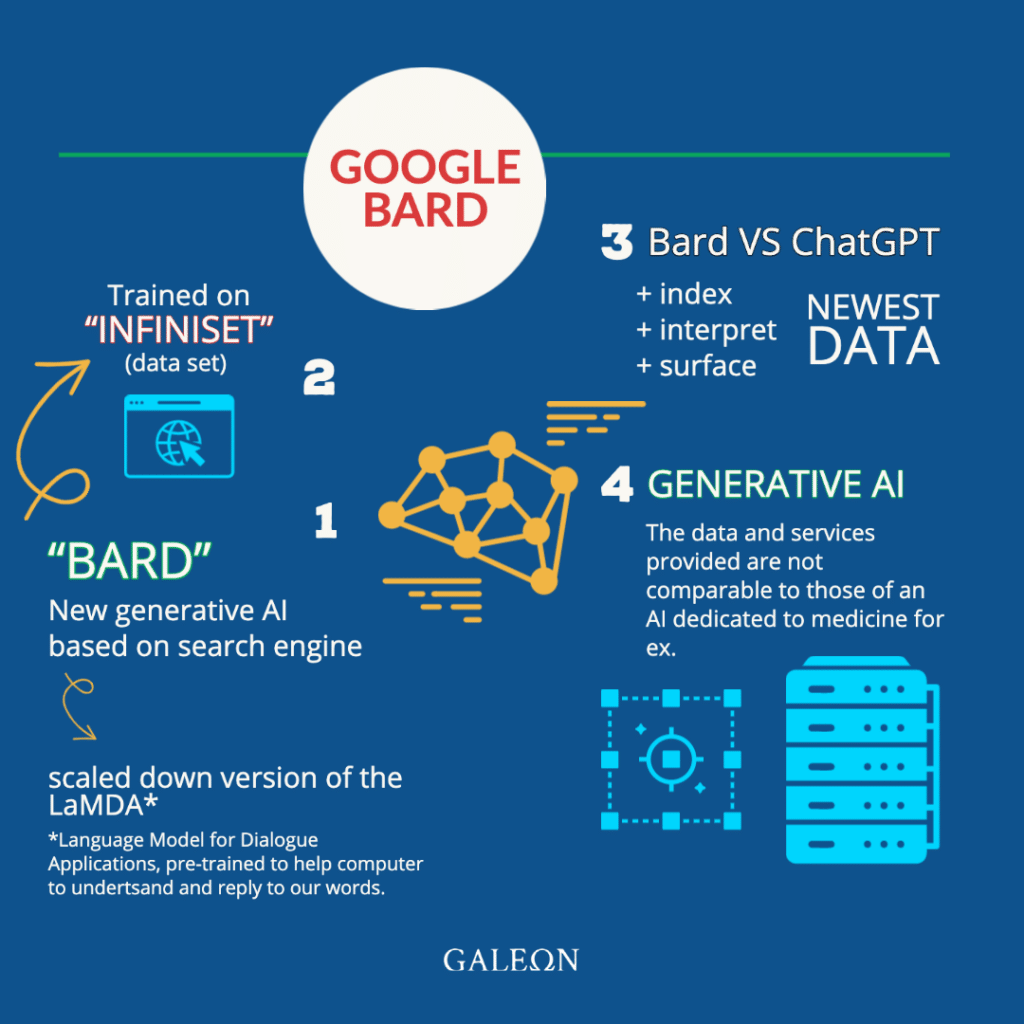While we were just getting out of the torrent chatGPT torrent that flooded absolutely all our social networks, it’s Google’s turn to bring out its joker card.
Indeed, Google introduces itself with Google Bard (“Bard” for friends).
A tool to exploit the advanced capabilities of what is called generative AI, Artificial Intelligence generating content.
No need to go back to the conference given on this occasion on February 8, 2023 (“Google Live from Paris”) and the few setbacks that were noted, but let’s rather try to understand the added value of Bard.
In addition to its mode of operation, we will also study its position in relation to other projectsof Artificial Intelligence, especially in the field of medical AI.

1/ Google Bard, the generative AI revolution according to Google
Before we give you a taste of what Google Bard will be like, let’s first go back to the concept of generative AI.
A. Generative AI, artificial intelligence at your service
If you’ve ever dreamed of being able to conjure up just about anything you wanted with a magic wand, well, generative AI is pretty much all of that (to some extent, of course). ?
Like an artist, a generative AI creates new things, all by itself. In this case, it generates content.
Generative AI is therefore a kind of computer program that uses rules and examples found from a database to create new content, such as images, music, text or even voice.
Using these rules and examples, generative AI can create things that no one has ever seen before, like a new song or a new picture.
Imagine that you give instructions to a robot to draw a cat, but you don’t give it an example to copy.
Instead, the robot uses rules to draw a unique cat, as if it were creating a new cat from scratch.
Generative AI works the same way, except that it follows rules in order to create new things.
B. How does Google Bard’s generative AI work?
Bard is a computer program based on search engine technology.
1/ Bard, a smaller version of the LaMDA
Google Bard is an adapted version of another technology called LaMDA (for Language Model for Dialogue Applications).
This is a combination of conversational neural language models trained on over 1.56 trillion words (million billion)*.
*1.56 trillion words can also be expressed in “petabytes”. Knowing that a byte is a computer storage unit containing a single character, such as a letter or a number. A petabyte is equal to one trillion bytes, which is equivalent to 1.56 trillion words.
To understand this last concept, just imagine a teacher teaching a computer how to receive all the information given by a human.
A sort of decoder capable of understanding both the words expressed and the questions asked in order to answer as naturally as possible.
Bard is trained from the “Infiniset” database.
The latter is nothing less than the backbone of Google Bard, composed of a multitude of data coming for example from dialog boxes or public forums, web texts, C4 data (graphic technique allowing to understand the functioning and the architecture of software)… etc.
2/ The added value of GoogleBard?
At this point, it’s not really clear whether or not Google Bard competes with other generative AIs like chatGPT.
The project representatives argue that this AI will allow for much more up-to-date information to be indexed, analyzed and reformulated in even more precise ways.
What is certain is the ability that Google Bard offers as a tool for understanding natural language with great accuracy.
In this sense, Google Bard innovates in the field of speech synthesis, not requiring repetition or rephrasing from the user.
3/ Google Bard, AI accessible to the public
It is important to note the difference between Google’s generative AI and OpenAI’s, which aim to answer questions based on data that may or may not have been initially validated, from an AI specifically designed to solve technical problems.
We are thinking in particular of all the emerging projects that develop AI for prediction models, for example, in the insurance, finance or meteorology sectors.
Google Bard is there to answer questions based on supervised learning.
In the medical field, for example, it would be ridiculous to simply rely on Google Bard to get answers or make diagnoses.
While medical AI, as developed by Galeon for example, will enable new problems to be raised from a set of highly structured and specific data.
Thus, in the long run, this technique called blockchain swarm learning will help advance medical research.

Conclusion
- Google Bard is a new generative AI developed by Google based on search engine technology (a scaled down version of LaMDA).
- This technology can understand and respond to natural language more accurately and efficiently.
- The Infiniset database is the backbone of Google Bard.
- It is important to differentiate generative AI from other AI that aim to solve technical problems, such as the medical AI developed by Galeon.
- Google Bard is an innovative tool for answering questions in a more natural and fluent way, opening new perspectives in the field of speech synthesis and natural language processing.




0 comments